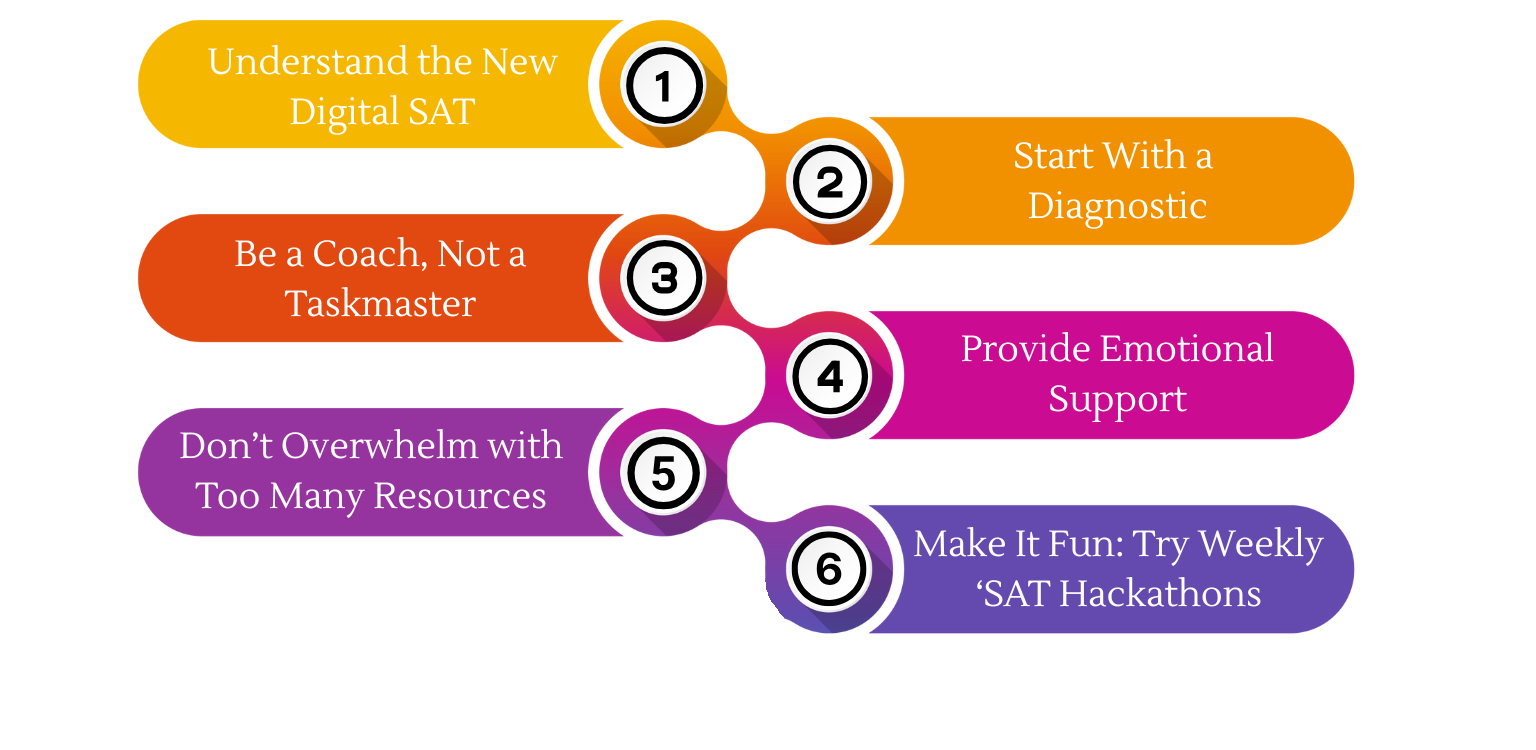Imagine your teen walking into the SAT testing room, shoulders back, calm smile, ready to tackle whatever pops up on that screen. No frazzled cramming the night before, no teary meltdowns over practice tests – just a quiet confidence that comes from the right kind of prep.
And here’s the thing .. that confidence? You can help build it. Not by forcing endless drills, but by shaping a prep plan that fits your child, their personality, and their pace. You’re not just cheering from the sidelines-you’re part of the engine that gets them there.
In this blog, you will learn how to balance emotional wellbeing with smart scheduling, deploy fun yet data-driven home routines, and leverage official digital tools to monitor real outcomes, all without pressuring your child. This will ensure that SAT prep is done with empathy, structure, and maximum impact. So, dive in for a parent-optimized SAT prep strategy!

Understand the New Digital SAT
The SAT is now fully digital and adaptive. This new format was introduced in 2024 and requires students to complete two modules each for Reading & Writing and Math, and the second module adapts based on how they perform in the first. The entire test takes about 2 hours and 14 minutes, not including a break, and includes smart tools like a built-in graphing calculator, on-screen timer, and question flagger.
Understanding the format helps you set realistic prep goals and steer your child toward perfect preparation. It also means you can spot where nerves and not lack of knowledge, might trip them up.
Start With a Diagnostic
Before your teen opens a single prep book or fires up a practice app, give them the gift of clarity-start with a full-length official practice test. Think of it as their SAT “health check-up.” This baseline assessment identifies strengths and weak areas, crucial for mapping a focused study plan. Most experts recommend repeating this diagnostic 2 to 3 times across the prep journey. Maya, an 11th grader working with LilacBuds, discovered early on that her math accuracy dropped sharply in the final 15 minutes – not because she didn’t know the content, but because she panicked about time. With that insight, her prep shifted toward timed drills and pacing strategies. You could reach out to the LilacBuds SAT expert coaches who can help your child navigate this stage.
Be a Coach, Not a Taskmaster
Your role isn’t to control every session; instead, it’s to keep structure in place. Set a realistic study schedule (about 20 to 30 minutes daily), use visual planners, and encourage weekly goal setting. Parents we’ve worked with say this approach kept peace at home and boosted scores—because routine builds confidence, while last-minute cramming only fuels stress.
Provide Emotional Support
Test prep isn’t just academic; it’s emotional too! Celebrate small wins, normalize setbacks, and ensure sleep, nutrition, and downtime are part of the prep cycle.
Parents who had enrolled with us for SAT coaching, and were following this approach at home, tell us their kids were more focused on test day and the lower stress improves memory retention and decision-making under pressure. Remember, your tone sets the mood at home—when you stay grounded and encouraging, your teen learns to approach challenges with the same steady confidence.
Don’t Overwhelm with Too Many Resources
When it comes to SAT prep, more isn’t always better-it’s just more. A mountain of books and apps can leave your teen feeling swamped instead of supported. Stick to targeted content based on diagnostic feedback. Avoid ‘over-supplementation,’ which can lead to burnout. LilacBuds SAT experts can provide targeted resources to help your child improve their chances of acing the exam.
Make It Fun: Try Weekly ‘SAT Hackathons’
Yes, test prep can be fun, if you frame it right! Organize weekly ‘hackathons’ at home, such as timed vocabulary challenges, logic puzzles, or reading games. Add a scoreboard. Offer small rewards. This way, you can transform anxiety into engagement.
Final Thoughts
Your care and encouragement are the secret ingredient to your teen’s success-not by micromanaging, but by steadying their “learning ship”. Being their anchor means knowing when to guide, and when to bring in extra hands. Sometimes, that’s a specialized coach who can give one-on-one, targeted prep. It’s not a sign you can’t help—it’s a smart way to maximize results. At LilacBuds, we’ve guided several IB and IGCSE students toward their best scores, with strategies that balance confidence, structure, and real progress.















